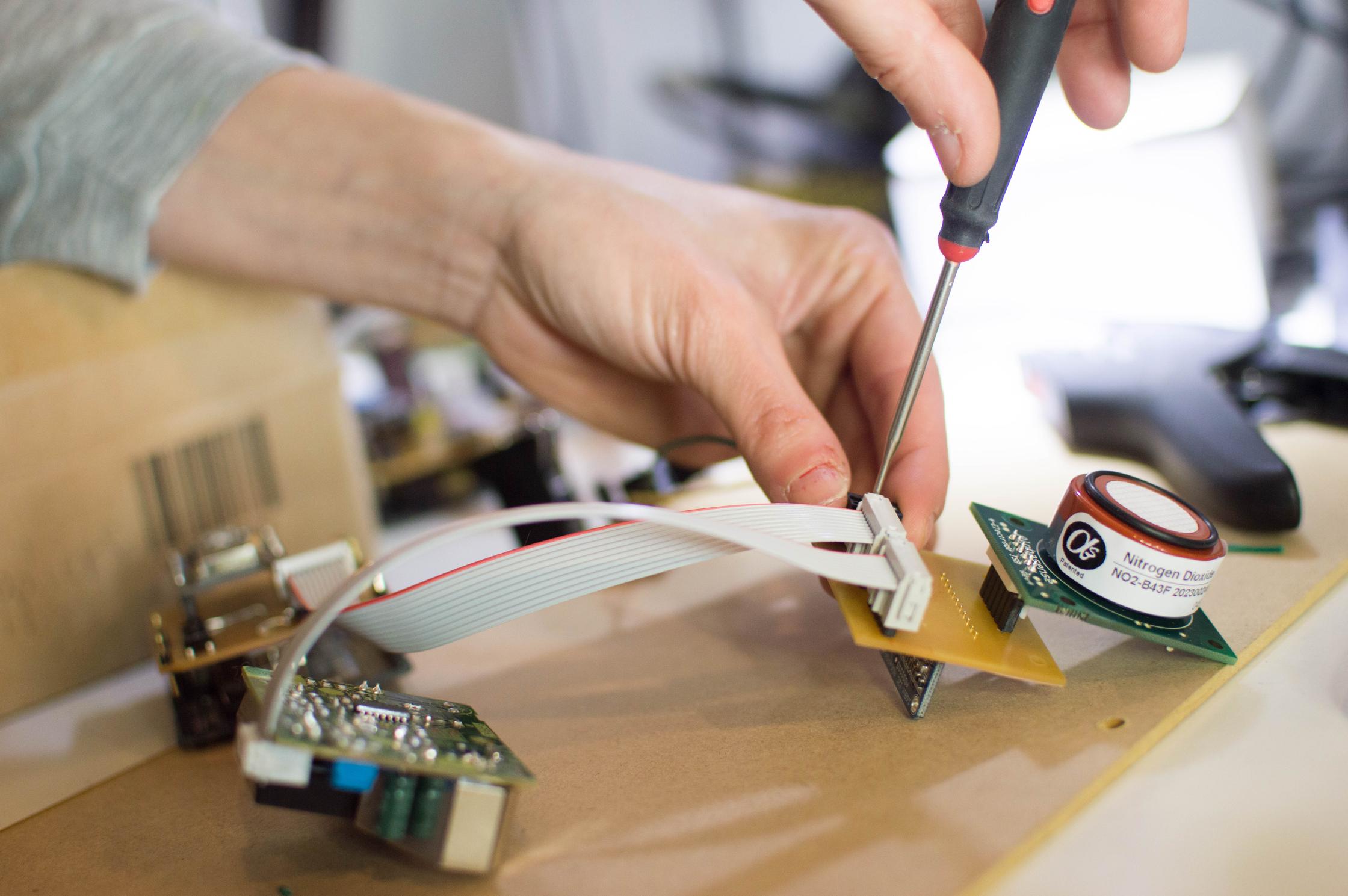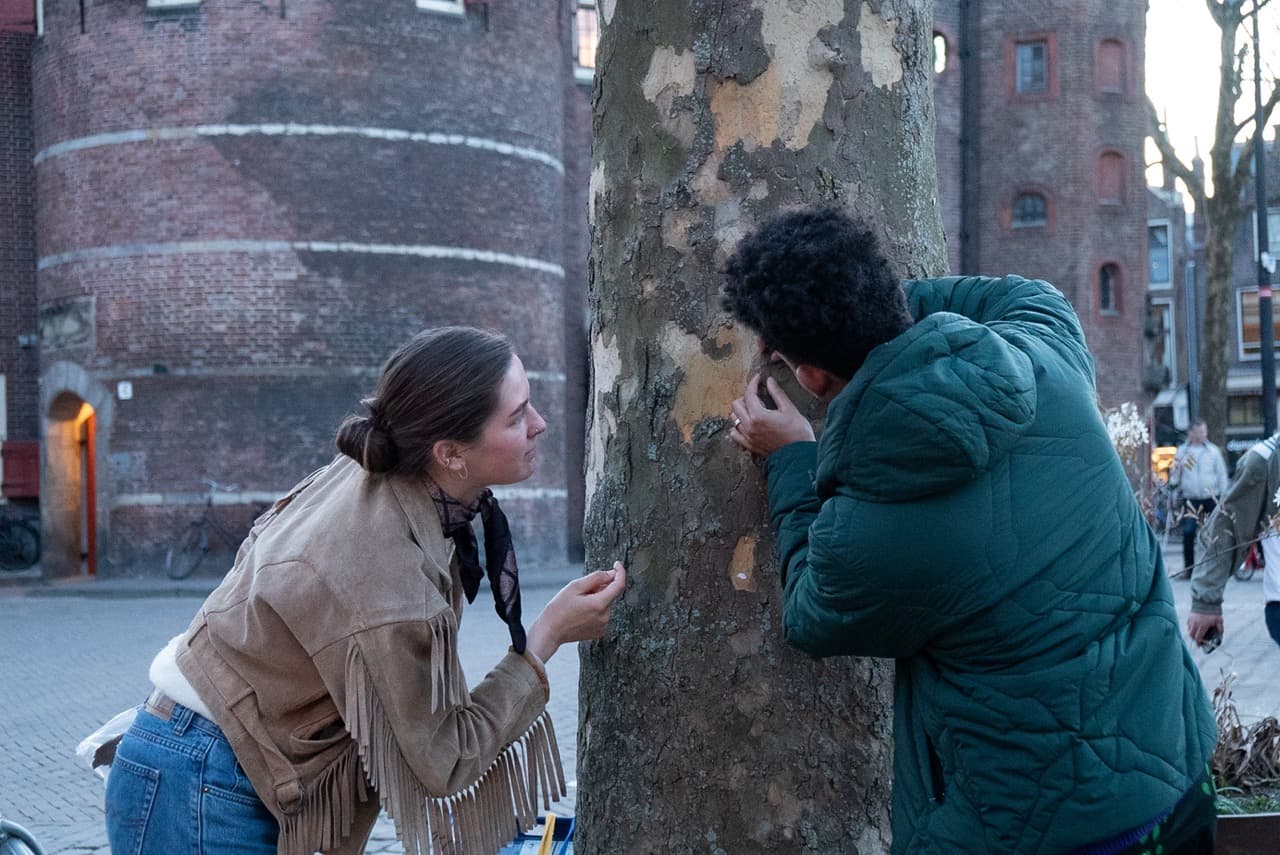Citizen Sensing
Our society is built on the knowledge we produce. Waag works on the basis of public research. Unlike scientific research that focuses on truths, public research focuses on the lifeworld of citizens and resulting issues. It democratises knowledge production, based on the idea that everyone has relevant knowledge, experience and skills to contribute to research.
For over 10 years, Waag Futurelab has been working with the public research method citizen sensing; research by residents in which they themselves use open-source tools to measure their living environment and learn to interpret it. The data gives them a stronger position in the conversation with governments, knowledge institutions and companies about a healthy living environment. Waag looks back at 10 years of citizen sensing: what have we learned since then? And what developments do we see?
Society as a research community
The idea that residents can also conduct research is (still) not always accepted in the scientific community. In the project Doing it together science (DITOs), Waag and the European consortium, took the relationship between science and residents to a new level. Project coordinator of DITOs Muki Haklay on the impact of DITOs: "At the time of DITOs, citizen science was just emerging. DITOs saw an opportunity to strengthen citizen science and make it more accepted. We brought the relationship between resident and science all the way to DIY research."

Around the same time, Waag and European partners experimented with different forms of collaboration between residents, scientists, technologists and local authorities in the project Making Sense. For the first time, knowledge institutions like GGD and RIVM were involved from the beginning of the research done by residents. RIVM especially supported residents in their questions.
Hester Volten from the RIVM offered her help: "[after the Smart Citizens Kit Amsterdam] a colleague of mine concluded that you couldn't say anything with the citizen measurements. I regretted that: you don't want to draw that conclusion afterwards, you want to help people beforehand. By coming to meetings, RIVM was able to help people from the beginning with their questions and what they could and could not measure with the sensors."
The lessons from Making Sense have been compiled in Citizen Sensing, a Toolkit. This toolkit of methods to shape the collaboration between residents, scientists, technologists and (local) governments became a cornerstone of Waag's citizen sensing projects.

The importance of FabLabs and open technology
FabLabs and other makerspaces create new opportunities for low-threshold innovation, using open hardware, digital fabrication such as 3D printers, community software and knowledge exchange.
The first citizen sensing project Waag was involved in was Geluidsnet in 2004. The Geluidsnet foundation wanted to use sensors installed on residents' homes to demonstrate that it was possible to measure aircraft noise. As an internet pioneer, Waag provided the necessary server facilities. Furthermore, the sensors, developed by TNO, were not yet accessible to (other) residents.
Thanks to the establishment of Waag's FabLab in 2007, many new open technologies were developed, including sensors to measure the environment. This made sensors more accessible to residents and allowed similar projects to start. Through its FabLab network, Waag worked with FabLab Barcelona and local residents on the Smart Citizen Kit in 2014. The open-source Smart Citizen Kit could be built and used by residents themselves to measure important values such as carbon monoxide (CO), nitrogen dioxide (NO2), temperature, humidity, light intensity and ambient noise.
Meanwhile, the collaboration between FabLabs and makerspaces has led to many different new sensors and technology. From gamma meters that measure radioactive radiation, to sound meters and thermometers that measure indoor heat.
Citizen sensing strenghtens democracy
Citizen sensing shows that technology can be used to strengthen democracy. The power of citizen sensing is not in individuals doing research, but the cooperation between different parties that leads to new insights and actions.
"A fundamental part of citizen sensing is action perspective. This often involves thinking about what residents can do. But action perspective is also needed for policymakers: what can they do with citizen sensing research? For example, harnessing the local knowledge network they are building. That development is now gaining prominence in our citizen sensing projects." - Imme Ruarus, head of Waag's Smart Citizens Lab
Collaboration between these parties is essential in citizen sensing for Waag. Change does not come from one group, it is a process of friction and collaboration.
"It is often thought with measurement data the solution comes naturally, both by residents and policymakers. But one of the most important things citizen science delivers is dialogue. Waag is very strong in how you shape that dialogue. What are you going to measure? What is your methodology? What are you going to do with the results?" - Hester Volten, RIVM
Waag's projects have provided new tools and methods for anyone working with citizen sensing. These include democratic data analysis, question-driven work, accessible data visualisation tools, and a handbook on public-civilian collaboration. These are collected in the Co-creation navigator.
Citizen sensing strengthens cooperation between different residents and parties, by finding a shared starting point, purpose or understanding of each other. It thus strengthens democracy and the resilience of society. It enables people to (re)gain a grip on their living environment.

New technologies, new possibilities
Thanks to the knowledge on open technology and collective research, Waag can take new steps in the field of citizen sensing. New open technologies can empower residents in their research and strengthen cooperation between knowledge institutions, residents and governments.
"First the question was: can we build a sensor with which residents can measure their environment? Because if you control the technology yourself, you can make your own choices about what, where and when to measure. Now AI is starting to play a role in citizen sensing. By developing technology together with residents, you build in social value," says Imme Ruarus.
In addition, new technologies and methods can ensure better integration of citizen sensing into policy. For example, Waag is working with European partners to connect citizen sensing data with the data authorities need for enforcement purposes. For example, by examining the use of AI to improve data quality.
But the goal of citizen sensing has never been to put up as many sensors as possible to collect data. Ruarus: "Technology has a big impact on the planet, so you have to be critical when you deploy technology. We are also exploring other ways of collecting knowledge about our living environment. Lichens or plane tree bark are bio-sensors that can tell us something about air quality."
Thus, Waag continues to explore what new technologies we can open and work towards a future where citizen sensing is a regular approach for residents, scientists and governments to work towards a better society.
Timeline
2004
Waag gives technical support to Geluidsnet, an initiative by residents to measure aircraft noise themselves.
2007
Establishment of FabLab Amsterdam, first Fablab in Europe.
2014
Start of Waag's Smart Citizens Lab.
2014
In the pilot Smart Citizen Kit Amsterdam, Waag worked with residents, scientists and the municipality to investigate for the first time the extent to which you can collect data about your immediate living environment yourself using open citizen measurement sensors.
2015
In Making Sense, Waag and European partners experimented with different forms of collaboration between residents, scientists, technologists and local authorities. In 2016, Waag coordinated citizen sensing pilots in Amsterdam, Barcelona and Kosovo.
2016
In Doing it Together Science, Waag and the European consortium took the relationship between science and residents to a new level: DIY science. Waag and partners engaged people throughout Europe in citizen science with the citizen science bus tour.
2018
Citizen Sensing, a Toolkit which describes all the methods, lessons and best practices from the Making Sense project. It forms a blueprint for policymakers, city makers and other actively engaged citizens to facilitate locally driven data collection. Citizen Sensing, a Toolkit became the cornerstone of Waag's citizen sensing projects.
2018
Making Sense with its Citizen Sensing, a Toolkit received the honorary mention of the European S+T+ARTS Prize.
2018
In AmsterdamSounds residents, the ombudsman and the municipality measured hotspots of noise nuisance.
2018
In the pilot of Hollandse Luchten residents built the HoLu-Sensor kit and used it to measure air quality with the government and experts.
2021
In Thermo-staat residents measured indoor temperatures and discussed solutions against heat stress with researchers. Investigative journalists brought the stories of the measuring residents to the general public.
2022
In Hollandse Luchten residents measure air quality with sensors. Together with Waag, governments, health experts and data analysts, they discuss the measurement data to improve air quality together.
2022
De citizen sensing methodes that Waag develops are published on the Co-creation Navigator.
2023
RIVM named the Amsterdam Sounds sound meter the best in their test!
2023
In the Houtstook pilot residents explore with Waag, TNO and the environmental service whether you can measure soot from wood burning with sensors.
2024
After Thermo-staat residents reported that they feel more enabled to raise heat stress issues and advocate for solutions. Housing corporation Ymere installed solar shading as a result of the project.
2024
Citizens as well as experts evaluated the official air monitoring network of North Holland.
2024
In Automatic suspicious cloud recognition Waag and the University of Amsterdam together with IJmond residents developed an AI tool to identify suspicious clouds coming from the Tata Steel factory site.
2025
In Enforce Waag is working with European partners to connect environmental data collected by citizens to the data needed by authorities for enforcement purposes.
2025
Waag became a Zoöp! As a Zoöp, Waag is researching new natural ways of measuring the environment within its Smart Citizens Lab. For example, through tree bark (de Plataancheck) or with lichens.